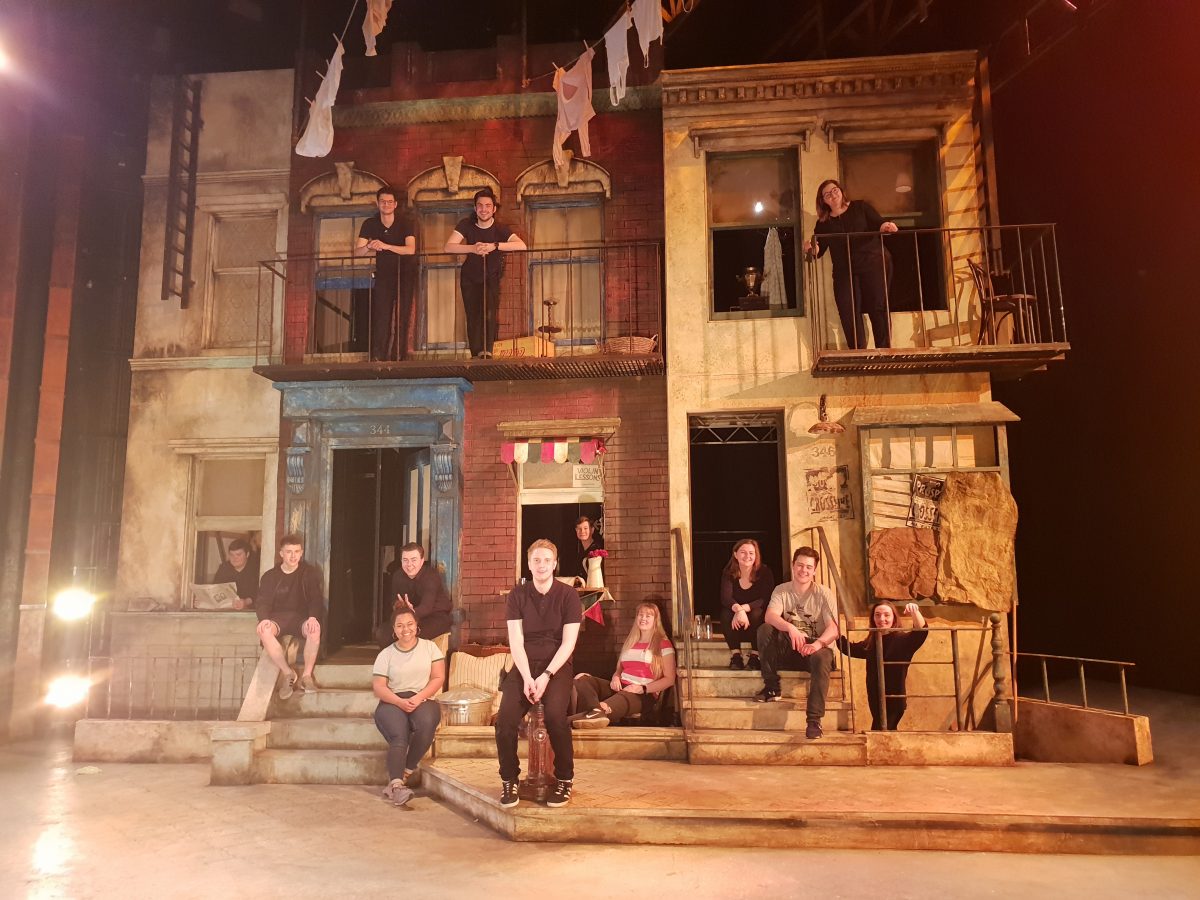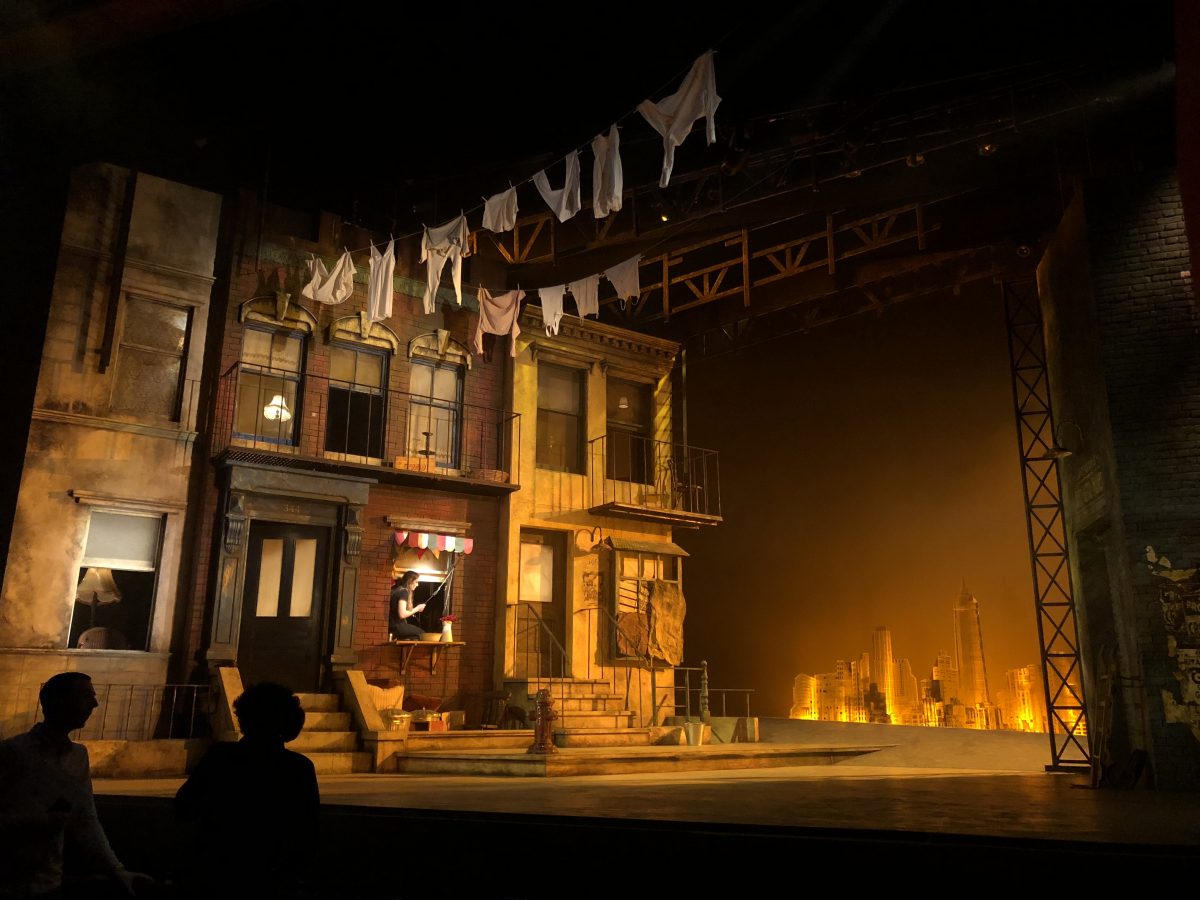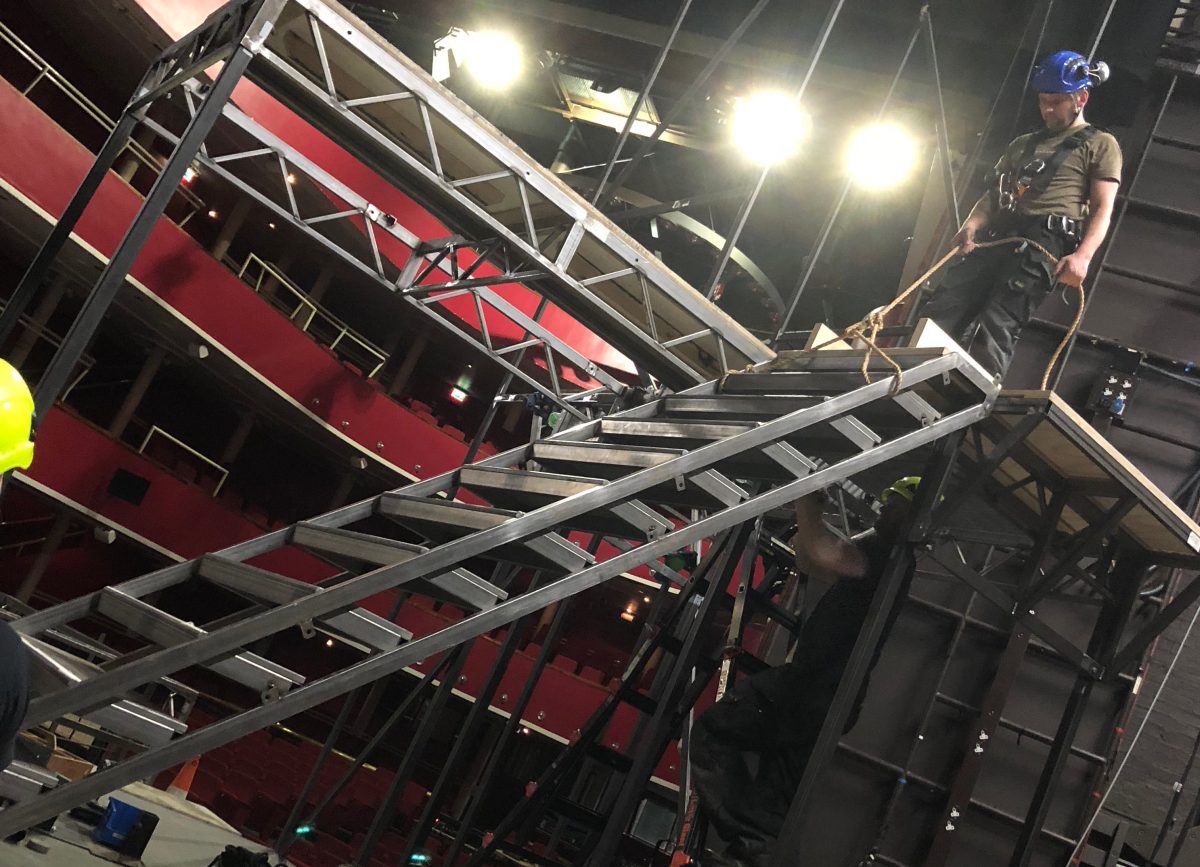In conclusion, Opera has been a varied experience. I’m inclined to think that, had Workshop noted their difficulties to the other departments earlier, some of the last minute headaches and stresses could have been avoided – though these provided learning opportunities of their own to deal with. Though it appeared grandiose, the show was boring to run on a day to day basis, though I suppose given my lack of experience as a flyman this was a preferable way of easing into the role. Overall, however, this Opera reaffirmed my belief in myself and my ability to be a TSM. Be it covering for Dimitri, devising solutions to problems in the moment, or putting in the necessary planning and paperwork before rig day to ensure we were as efficient and smooth running as we could have been, I feel like this allocation has proven – if no one else then to myself – that I know what I’m doing. Now, let’s see if that self confidence lasts more than a week.
Tag: Opera
Act Three
With Flyplot v6 proudly gaffer taped to the flyrail, I sat through Stage and Piano and Stage and Orchestra sessions so repetitive that I knew this show to a greater level of detail than pretty much anything else. The teething problems that had come up regarding the automation desk had been sorted; turns out it helps if your flying piece is not screwed in position and is allowed to move freely. I remembered – eventually – how to programme multi-target moves, and the chain effect that had been secured to the flying lines actually sounded pretty good. These sessions were also when it became apparent that it was going to be a slow, slow show. Nothing live flew apart from the house black and the garage door, with that effect only happening once for all of 14s. It was at this point that we made the decision to request the crew be moved onto other shows, reasoning that they could learn more at the Citz or on CPP than they would standing around in a wing doing nothing for three hours. Dimitri, myself, and Fi would deal with anything that needed fixing in the morning sessions we had, but apart from that I’d be on flys alone; left to journal and write time-sheets. Once again, the flyman loneliness would kick in occasionally, my only point of human contact being Karyn – our LX op – and Susannah – our DSM. It was unfortunate that my conversations with one often concerned the other, but when you’re bored you notice the little things; like not receiving standbys or having GO yelled without a cue number. If there had been more than one cloth in this show, this would likely have proved a severe issue. As it stood, it was little more than an annoyance, and didn’t affect me drastically more than giving me something to write for the show report.
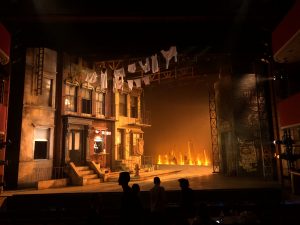
Our (Finally) Completed Set
A conclusion was made during our Wednesday night performance; Rebecca Bell is amazing at her job. As if the show hadn’t been going bad enough, a gentleman in the circle began to suffer health problems to the point that a show stop needed to be called. That was, once Front of House decided that having paramedics in the auditorium may be interfering with other audience member’s enjoyment of the piece. Calmly, Rebecca informed the audience that we would be holding, and commanded Karyn and I to get in a suitable lighting state and bring the full black in. In the fifteen minutes that followed, communication was maintained with every department as we waited to hear what we would be doing. Rob – our conductor – was tamed after he tried to yell at Stage Management when he was calmly informed of what was happening. I observed all of this from the small gap in the German masking at the DS point of the fly floor, adrenaline rushing at this new experience. You always remember your first show stop. When the time came to recommence, Rebecca told everyone exactly what she needed us to do, and to rapturous applause from the audience we restarted the show – just in time for the ice cream sextet. A situation like this needed a calm, controlled response, and Rebecca delivered. A notable downside, of course, being that Act 1 lasted 15 minutes longer than its already bloated running time.
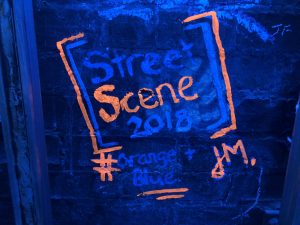
My First Addition to the Fly Floor
Four shows went up, four shows came down, and with the final curtain the strike reared its head. I believe that everyone knew it was going to be at least a little bit painful, though the happiness on everyone’s faces at 9am that Saturday morning didn’t really show it. Between the sun shining through the opened roof and Dave’s yellow Hawaiian shirt everything was bright and cheery. My first priority was to grid as many bars as I could to allow the house to be attacked by workshop, then run motor control cables for the build motors to be plugged back up. Next, everyone set about taking down the SL dog legs and hard masking, retaining the steels on the flats so Ballet wouldn’t have to waste time re-running them. The garage door and its flats came down and were laid off to the side, before the rake started to be taken up piece by piece – allowing us as much open access to the dock as we could get so as we could begin shipping pieces into the StageHire van waiting for us in the loading bay. The houses came down a lot quicker than they went up, all of the additional onstage welding managing to be cut out with little to no hassle. By lunch time, most of the upstairs sections had been removed, with these safe grid panels, access treads, and front flats being removed pretty quickly once we got back. The pit infills came out with a few ‘gentle’ taps from a mallet and the floor panels were re-fitted and re-skinned. And then we kinda stopped. Malki and Dave had come to an arrangement with Dimitri that – whatever state the Ath was in at 7pm – everyone would go home. It was, in fact, 7:15 by the time we actually vacated, and I wasn’t the greatest fan of what we had left behind. Metalwork was stacked on the back wall, the dock was filled with bits of flat, pavement, and balustrade, and the void was a shambles of LX cabling and untidy blacks. I’d likely have cared less if I wasn’t aware that I’d be fixing it come Tuesday when we began work on ballet, but – either way – I didn’t like not leaving the venue as clean as I would expect to have found it. Having put so much effort into the rest of the production, it felt like we’d half-arsed a strike; and no amount of Malki logic could quash that feeling. However, as Stevie’s schedule commanded, we migrated to Jacksons for a well earned celebratory Ribena. At last, it was finished.
SaveSave
Act Two
A lesson about time management; starting your fit-up half a day early is a beautiful thing. Due to the fact we second year TSMs had finished our rotating flats exercise earlier than expected, the overhead fit-up started at three o’clock. I slowly but surely found my rhythm on the fly floor, and by the time we had hung around half of our softs I felt very confident in my ability to fly, weight, re-weight and take out bars. The electrics team were more than willing to cooperate with our space needs, working in and around us to hang their bars to the point that – by 9:30pm – around 80% of our overhead work was done. Naturally, this was very exciting, and had me reminiscing about the Caesar strike day where it was proved that, with the right amount of drive and enthusiasm, you can achieve a lot in a short period of time. One thing that I did come to realise, however, was that the books I’d read on flying and the people I’d spoken to were correct – being a flyman is a lonely job. From my man-cave at seven metres I watched my H.O.D. and the crew work away, feeling slightly disconnected from the experience. For the 9am sessions, this was great and let me slowly shake off the sleep without being thrown into anything too taxing. Anything later than that, and I put on my DTSM hat once more and mucked in on the ground.
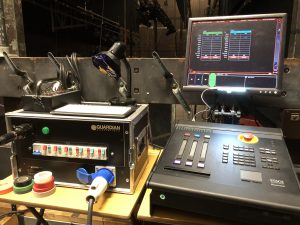
Neat and Tidy Motor Control
The arrival of the set was met with a resounding happy horror. The truck was packed to the rafters, and everything our eyes settled on had steel in it in some way or another. The tip took two hours in total – a fact that was not aided by our ever-helpful production manager driving a sprinter filled with ply into the loading bay, and telling us it had to be unloaded pronto because it needed returned to the garage. Despite this fact however, and with a new personal best for disagreeing with workshop about how to lift something achieved, the set made its way onto the Ath stage. At 9pm, and looking at the fire hazard we had just created, it dawned on some of the mammoth task we were about to embark on. Similar to piecing together a Meccano set – if the pieces needed welded together and lifted by crane. This may be an element to blame for the fact that the pace of the crew slowed down drastically from hereon out. At times, it felt to Dimitri and I that no matter how hard we pushed ourselves physically, the mountain of things needing done just would not decrease in size. This was made worse by the one and a half hour session that had to be dedicated to re-positioning automation points when the garage door moved further onstage – the beams requiring shuffled around from all over the grid and ratchet strapped to the nearest structural thing we could find. It was a rough three days, and the scars and blisters from it are only now starting to fade. However, credit to the persistence of the crew, we managed it. The house was finally up, and all safety lines and motors detached from it. The garage door was rigged to its automation points, and the rake was – pretty much – in. Anything else that needed done could surely be dealt with swiftly and simply with nothing but a rattle gun and blind optimism – right?
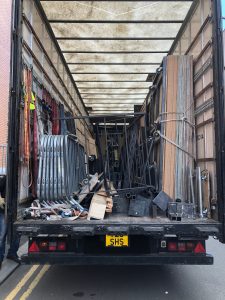
Our Lovely Arctic
Oh how naive three weeks ago Jamie was. Dimitri’s patience running about as thin as his forearms, he decided that the TSM team would fit the walk down traps – his reasoning being that if they weren’t in place for the health and safety induction then we may as well not run one. I completely agreed with him, and – with the team – we installed the treads and deck on the DS set with very little hassle. We lifted the large tread set into place with rope, running it through a friction pulley which we’d stropped around a length of truss which spanned the gap on stage level. This helped fight against the piece dropping and let us position it easily before we drilled two bolt holes through it, and the metal infill, and secured them together. The US set started out well also – until we realised that it needed a check out of it to fit because of an overhang in the structural beams of the floor. This would be left for workshop to fix, as we feared any attempt could render the entire operation a failure. Our next issue to resolve was the counterweighting of the windows. The time for interior counterweighting them had passed in the build phase, with our only option now being to attach ring screws to the sliding window panels and run sash up to pulleys, attaching sand bags at the other end. Turns out, windows are a lot heavier than they seem, and each took around 3 or 4kg of weight spread between the two lines before they held themselves properly. What also became apparent at this point was that the windows couldn’t open nearly far enough for the performers to climb out of them. A shame, given the fact that it was the only access and egress method to the two balconies. This was resolved by taking a section of the top timber out by jigsaw, letting the window move out higher than the frame and creating a gap large enough for the performers to fit. It was ugly, but it was necessarily practical. It would later seem that each run of the show would throw up another window that needed to be made practical, to the point where some of our rigging solutions were quite ingenious – fashioning clew plates from sash, and adding pulleys along the live line to page it out of the sightlines of the audience. This work was hot – due to the cramped nature of the structure and the fact that LX took any time they could to work on their rig, as full with tungsten as it could be. It also tested me to trust in my own solutions, making amendments and alterations to the face of the structure in order to bolt through flats for room dividers, and semi-structural timber battens to hang our counterweight pulleys. It was at this point that I felt like a ‘stage guy’ for the first time; and it was not a bad feeling at all.
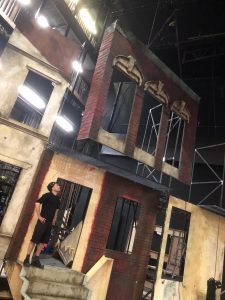
Everything Raising Into Place
I do not completely share my HODs opinion on the Workshop team, though I do sympathise with it. The evidence spoke for itself, workshop were swamped on this show. Be it the fact white card was late, the fact that Spring Awakening ran over, or the pure fact that they are under-staffed, they were not ready to put that set into that venue. As understanding as we could be about the fact that it was essentially just Matt and Simon that could do the heavy welding and joinery – with a very talented, and truth be told amazingly pleasant, external carpenter brought in solely to build the rake due to its complexity, the amount of things we were waiting to be delivered or were just not built was concerning, and led to the uncomfortable situation of having Adrian complain to us about how his design was being affected. This came to a head over the issue of the fire-escape ladders. From white card through to the final plans, it had been shown that the houses would have two escape ladders near the top to – as Adrian put it – ‘show that they expand wide and tall’. These appeared to have been quickly forgotten about by Workshop to the point where – four days before preview – it was admitted that they would be built ‘if we get on to decoration’. Adrian is blunt at the best of times, but his response to this comment resulted in Dimitri drafting a construction plan for the ladders himself, and sending it to the props department to build with explicit instructions of how it should arrive so it could be hung. Of course, these were not adhered to, and it was a further 45 minutes on stage to build new mounting blocks and fixings before we climbed some ladders and screwed them to the facing of the flats. This was time that should never have been used on something so simple, and was the last straw that broke an already tired and sawdust-covered camel. As Malki noted, there is no easy fix to the workshop crisis short of commanding directors scale down shows or hiring in more people. However, if one of these is not done – and the communication issues that plagued this show and others like it are not fixed – shows will continue to be haphazardly assembled at the last minute. And there is only so many times that can happen successfully before one does not. Rant over, on with the show.
SaveSave
Act One
Opera 2 would be an allocation of firsts for me. It’d be the first allocation I’d be seeing from white card to closing night, it’d be my first TSM allocation in the Ath, and – perhaps scariest of all – it’d be my first time flying a show. Looking back on the experience as a whole now as I write this, I’ve come to realise how much it has impacted my practice as a TSM, and the ways in which it has reaffirmed my belief in my ability and my outlook on how I can progress and develop over the next year.
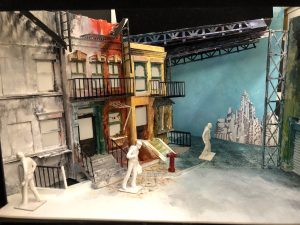
Our Very Colourful White Card
From the outset this show was different. Adrian – our designer – requested to meet with Malki and myself before the white card to talk through all of the stage-specific aspects of the set. The reasoning for this became apparent when we first saw the 1:50 model. This set was huge. An apartment complex sweeping DSR to USC, a motorised garage door flat masking off the SL wing, and a rake that scooped the back third of the stage up and of to the wings. Above it all, three truss-like bridge sections and two washing lines, combining with all the other elements to create a 1940s New York Street Scene. It was visually spectacular, and a really special surprise. From this meeting, a couple of things started to jump out. Pit panels would need to be removed, as the action would take performers into the basement of the houses through walk-down traps in the stage floor. The garage door would have to be practical, preferably moving with a chain noise that Malki
assured could be a practical effect on stage. The windows would also have to function, with TSM taking on the responsibility of counterweight sashing them and weighting them. Then, Adrian announced his final idea. He would like the front cloth to iris out from DSL at the top of the piece, and iris back in at the end. Rarely have I seen Malki visibly excited, though this announcement seemed to push him quite close. Armed with a list of concepts to look into, we sat through the full white card presentation helmed by Alexandra – our director – and started to examine the practicalities of staging this immense show.
One minor issue that presented itself early on was the fact that our TSM wasn’t in the country. Dimitri had spent 6 months of third year completing an equivalency in Greece, a sabbatical that had not yet concluded during the white card and final design process. As such, we ended up Skyping and emailing excessively, with me taking on some of the immediate TSM roles – looking into the possibility of trap infills and the practicalities of fitting an orchestra in and around the treads. As much as this was a challenge, communication proved really good. Dimitri continued his regular phone call check ins – sometimes for no other reason than to check I was okay. Though he wasn’t geographically close, I still felt like he cared about the project and was there to support me; something I definitely valued. In a combination of both curiosity and boredom I took a laser measure and drew the Ath pit in Vectorworks. From this, I drew on the proposed trap positions, some deck and treads, with the dual intention of discovering whether this exercise would be possible, and showing the conductor how much room would be removed from the orchestra. This also resulted in the delightful finding that the furthest DSR palettes still had fibreboard underneath them, and this would have to be removed before we could make use of them at all; one of these pieces of the Ath’s design that is seemingly pointless, existing only to try our patience.
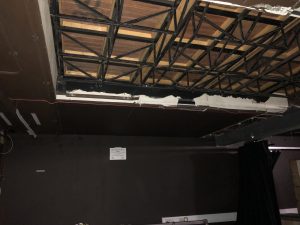
Because Fibreboard Under Removable Floor Panels is a Great Idea
And then – nothing. I was unable to attend final design, though from Malki’s notes, not a lot changed. The garage door would fly on automation, the iris would fly however the hell we could make it, and the set would arrive from workshop. It was March by this point, and Dimitri had returned to Scotland, bringing with him his trademark sunshine personality and carefree whimsy. In all truth, this was a blessing, as it allowed whatever small workload the TSM department had to manage to be taken up by someone other than myself, allowing me to take full advantage of the free time classes had given me to read, research, and write – an experience I have previously journaled about at length. During the production meetings I attended, nothing major came up – though concerns about the tightness of the schedule were persistent and perceivably unaddressed. Nevertheless, every department appeared to be progressing smoothly with no great obstacles standing in the way of being completed on time.
It’s rare that a lecturer phones you at home. Towards the end of the easter break I was doing some reading in bed when my phone started buzzing next to me. Of all the people I’d expected to be on the other end, the fact that it was Steve, searching for some rear-fold tab runners was quite alarming. These runners had been borrowed from Sottish Opera for the iris cloth, the rear-fold part meaning that the cloth wouldn’t bunch up as it swagged, keeping the leading edge sharp and achieving the desired look. Unfortunately, Scottish Opera wanted them back – and no one knew where half of them had gone. After my lack of knowledge of their whereabouts had been expressed to him on the phone, Steve would submit a plea to the Scene Dock facebook page before finally shelling out money from the Street Scene TSM budget to replace these items that neither Dimitri, or I, had seen or signed for. I have a few issues with how this panned out. The first, is that the quantity of these runners should have been checked when they were signed for. As much as Steve swore that we didn’t receive all that we had been expecting, the fact that this was assumed to be correct led to us buying replacements anyway. Secondly, there was no understandable reason for any other production to be using them, and the fact that they were not adequately secured away so that others couldn’t access them was an issue. Thirdly, and most telling, no one seemed to tell one another that they were in the building, or what they were being used for, or where they were being kept. As much as it may seem like yelling at a brick wall at this point, communication in RCS does not work, and information never seems to end up with the people it should. Nevertheless, with our TSM pocketbook considerably lighter, and our iris effect now cut in favour of a full black, we continued to prep for the fit-up.
SaveSave
Introduction
‘Street Scene’ is a two-act opera, written by Kurt Will in 1946. It takes place on the doorstep of a tenement on the East Side of Manhattan on two brutally hot days in 1946. The story focuses on two plot-lines – the romance between Rose Maurrant and her neighbour Sam Kaplan, and on the extramarital affair of Rose’s mother, Anna, which is eventually discovered by Rose’s irritable father, Frank. The show portrays the ordinary romances, squabbles and gossips of the neighbours, as the mounting tensions involving the Maurrant family eventually build into a tragedy of epic proportions.
Our production was directed by Alexandra Spencer-Jones, with design by Adrian Linford and Lighting Design by Charlie Morgan Jones. As a member of the Technical Stage Department – and as Head of Flys and Automation – this show presented a number of challenges. Most evident was the scale of the set; a tenement block over three floors – one descending into the basement of the stage – a raked upstage area, and a practical garage door. All of these elements combined to create a set that was visually spectacular, but difficult and heavy to assemble on stage, resulting in this allocation testing everyone’s technical ability, as well as their abilities to work under pressure and remain self-motivated.

